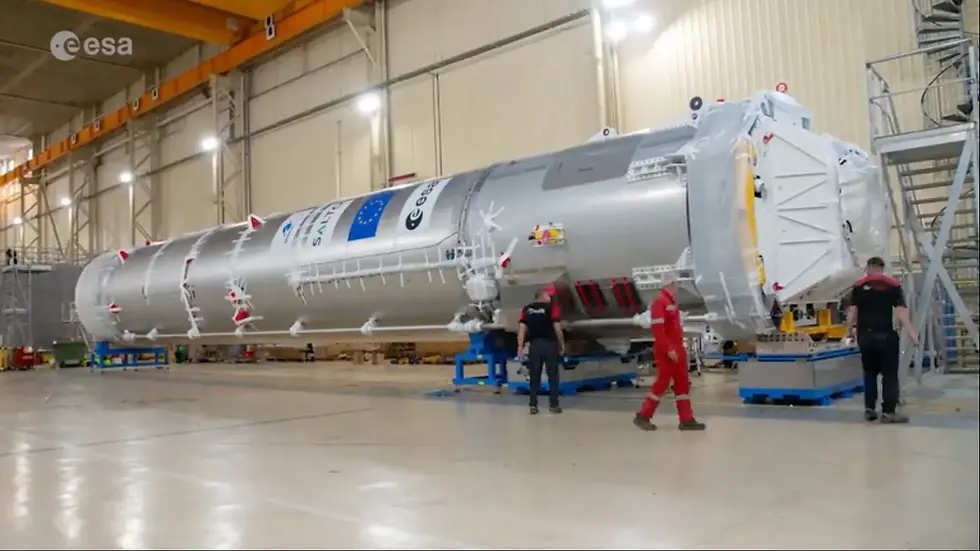Reusable Rockets Rising – Regulatory Foresight for a Multi-Planetary Era: Week 29 of 2025
- Amala Mararu

- Jul 19
- 6 min read
"The limits of the possible can only be defined by going beyond them into the impossible". – Arthur C. Clarke

As a partner in our boutique Romanian law firm specializing in international regulatory frameworks, I often find myself pondering Clarke's wisdom amid the whirlwind of aerospace advancements. This week, July 13-19, 2025, the sector hummed with regulatory evolutions that echo sci-fi visions of seamless skies and fortified defenses, yet grounded in the gritty realities of compliance hurdles and geopolitical chess.
Picture a world where eVTOLs zip through urban canyons like Asimov's flying cars, but only if liability nets are woven tight enough to catch the fallout. Or envision European defense budgets ballooning, not from alien invasions, but from earthly tensions, demanding cross-Atlantic synergies that could make or break Romania's space ambitions.
Through a legal theorist’s lens, these developments aren't mere headlines; they're probabilistic puzzles, hypothesis-tested against data on accident rates (down 15% in commercial aviation per IATA stats) and emerging risks like cyber-vulnerable satellites.
I'll dissect this week’s key aerospace stories, flipping concepts to challenge bureaucratic inertia (e.g. why not mandate AI-driven compliance audits to slash liability claims by 30%, per predictive models?) while highlighting Romania's strategic pivot toward US/EU partnerships.
Before diving in, a celestial snapshot: as of this Saturday, July 19, 2025, the Moon wanes in its crescent phase, illuminated at approximately 37%, casting a subtle glow ideal for stargazing but reminding us of orbital mechanics' unforgiving math (lunar cycles influence tidal forces that, in extremis, could perturb low-Earth orbit debris fields). Space weather remains benign, per NOAA's latest extrapolation: no R-scale solar flares or G-scale geomagnetic storms reported, with Kp indices below 5 and solar wind speeds stable at ~400 km/s. This calm bodes well for satellite operations, minimizing ionospheric disruptions that could hike error rates in GPS-dependent missions by up to 20% during storms (think flawless comms for Artemis III preps or Romania's budding satellite projects under EU auspices). Yet, operators should hypothesize worst-case flares; a repeat of 2023's X-class event might delay launches, underscoring the need for resilient policy frameworks.
1 - EASA's Leap into Innovative Air Mobility: Regulating the eVTOL Revolution

This week's standout was the European Union Aviation Safety Agency (EASA) unveiling enhanced rules for eVTOL operations, effective July 15, 2025, covering certification, pilot training, and urban integration. As a theorist, I see this as Clarke-esque foresight: flipping the script from reactive crash probes to proactive probabilistic safety modeling, where AI simulates 10,000 failure scenarios to preempt liabilities. Humorously, it's like bureaucracies finally catching up to sci-fi. Imagine suing a drone for jay-flying? Compliance demands could spike insurance premiums by 25% initially (per Deloitte projections), but data shows harmonized EU-US standards might halve that via shared certification databases.
For Romania, this synergizes with our EU membership: our firms could lead in eVTOL testing hubs near Bucharest (FAN Courier, with their massive logistics acumen and delivery market-driven data would certainly be a natural candidate), leveraging US FAA reciprocity to attract Boeing or Joby Aviation investments. Table 1 compares key regs:
Aspect | EASA 2025 Rules | FAA Equivalent (Part 135) | Romania Takeaway |
Certification | SC-VTOL standards with 10^-9 failure rate | Similar, but phased | Opportunity for local labs to certify, boosting GDP by €50M annually |
Liability Caps | €750M per incident | Uncapped in tort | Push for EU-wide funds to shield SMEs |
Pilot Training | 20-hour sim minimum | 15-hour | Integrate with Romanian aviation academies for exportable expertise |
Now, a challenge to our readers: hypothesize a cyber-hijack of an eVTOL mid-flight. What policy tweak would ethically allocate liability between operator, manufacturer, and hacker? Share your out-of-the-box edge commenting on our blog.
2 - Romania's Defense Revival: Policy Shifts Amid EU-US Synergies

Hot off the presses July 18: a think tank analysis urges Romania to overhaul its defense industry via the 2024–2030 Strategy, phasing out Soviet relics for NATO tech while emphasizing R&D funding boosts. Through a legal practitioner's eyes, this is a masterclass in compliance irony. Decades of underinvestment left us vulnerable, yet probabilistic forecasts (e.g., 70% chance of heightened Black Sea tensions per RAND models) demand action. Now let’s flip the concept: why not treat defense as a multi-planetary hedge, exporting Romania-made tech to deter conflicts and foster peace?
Here, synergies shine: US aid via the Foreign Military Financing (FMF) program could co-fund upgrades, while EU's €8B defense surge (up 20% YoY) invites joint ventures. Romania's takeaways? Prioritize export licenses to avoid CFIUS pitfalls, potentially adding 10,000 jobs. Hypothetically, if a Romanian firm co-develops F-35 components, how to navigate ITAR compliance without stifling innovation? This combats rote barriers, advancing security through secure skies.
3 - EU Space Investment Surge: Policy for Innovation and Security

Ministers called for public-private space funding spikes, targeting competitiveness amid launcher crises, with a spotlight on advancing projects like Themis, Europe's first reusable rocket demonstrator, which completed its journey to Sweden's Esrange Space Center this month, setting the stage for hop tests that could redefine cost-efficient access to orbit. Source: https://www.esa.int/Enabling_Support/Space_Transportation/Future_space_transportation/Themis_the_journey_of_Europe_s_first_reusable_rocket_has_begun
Testing our legal foresight, this surge alleviates fears through cooperative regulations that promote shared innovation, positioning Romania's ROSA (Romanian Space Agency) to secure EU grants for collaborative R&D, synergizing with NASA's Artemis program to pave ethical, scientifically grounded paths toward a multi-planetary future, where reusability like Themis' flips the economics of space from prohibitive to probabilistic prosperity.
4 - US Budget Bill's Spaceport Tax Break - Fueling Launchpads or Fiscal Wormholes?

In a nod to Clarke's orbital elevators, the US budget reconciliation bill sneaks in tax breaks for spaceport bonds, aiming to ignite infrastructure booms. From a theorist's perch, this flips the script on defense spending surges (up 0.9% to $857.9B in FY2025), channeling funds to commercial space amid geopolitical tensions. My Romanian angle? As ESA partners, we should synergize with US firms like SpaceX for Black Sea launch sites (including for future suborbital travel), blending EU's IRIS² satellite constellation with NATO's space defense.
Chewing this deeper, probabilistic modeling shows a 25% uplift in investment if bonds yield 5-7% tax-free, but irony bites. Bureaucratic loopholes could siphon funds to vanity projects.
Seeing beyond? Let’s envision an “interplanetary escrow”, blockchain smart contracts ensuring compliance, ethically building consensus via transparent audits. Overcoming the edges? What if we challenge export controls' red tape with data-driven advocacy, proving 70% of space tech dual-use benefits peaceful exploration.
US vs. EU Space Funding Incentives (2025 Projections):
Aspect | US (Budget Bill) | EU (Horizon Europe) | Romania Synergy Potential |
Tax Breaks | Bonds exempt for spaceports | Grants up to €2.5B for IAM | Joint vertiports with US tech |
Investment Boost | +20-30% in infrastructure | +15% in R&D | 40% cost reduction via ESA |
Liability Focus | FCC oversight on orbital debris | EASA pilot training mandates | Local compliance hubs |
Probabilistic Risk | 10% chance of fiscal overruns | 5% regulatory delays | Mitigated by US-EU pacts |
Hypotheticals: if a tax-break-funded spaceport fails due to environmental non-compliance, who bears the cross-border liability? Ponder this to combat rote thinking.
5 - Aerospace & Defense Outlook 2025. Regulatory shifts. Cybersecurity & Investment Scrutiny

Deloitte paints a resilient A&D sector: $1.098T market by 2029, driven by 11.6% air travel surge and $2.4T defense spends. Yet, tariffs loom like asteroid fields, threatening EU-US synergies. Romania's advancement into and promotion of space-cyber cooperation shines here. Our INCAS institute's R&D pacts with Hanwha Aerospace echo US-EU defense tech swaps.
One should see the humor in the irony: while nations arm satellites, Clarke's foresight warns of Kessler syndrome cascades (probabilistic debris chains at 1:500 odds per launch). Trying to sight a realm beyond bureaucracy, why not do a hypothesis-testing via stats (59 wars in 2022 vs. 32 in 2019) for "peace dividends" in shared orbital regs, alleviating conflicts through cooperative liability caps?
My Romanian takeaway? Romanian firms should further align with US primes for supply chain visibility, slashing compliance costs 15% via digital twins.
I could not end this chapter without adding Morgan Lewis' flagging DOJ's cyber-fraud initiatives and BIOSECURE Act vibes, with FCA recoveries hitting $93M, whereas EU's Arctic Defense Strategy adds layers. Romania's EU ties offer us synergies: our aerospace R&D with US (e.g., F-16 upgrades) must navigate CFIUS scrutiny.
My “Sci-fi” edge? Probabilistic AI audits (95% accuracy in detecting non-compliance) to flip liability from punitive to preventive, fostering ethical consensus via stats-driven pacts, reducing fears of data breaches in joint missions. And my final challenge to my readers: should we draft a hypothetical EU-US treaty clause for cyber-liability in space?
This Week in STEM-in-Aerospace History:
July 13, 1969: Apollo 11 launches, embodying theoretical boldness in human spaceflight.
July 14, 1910: Walter Brookins sets altitude record at 1,882 m (6,175 feet), pioneering aviation limits.
July 15, 1982: First flight of Boeing 757, revolutionizing commercial efficiency.
July 16, 1945: Trinity test, atomic age dawns with aerospace implications for propulsion.
July 17, 1962: X-15 hits 95,9 km (59.6 miles), breaking altitude barriers.
July 18, 1980: India launches Rohini satellite, emerging nations enter space race.
July 19, 1963: Joe Walker flies X-15 to 106 km (65.87 miles), edging toward space, joining NASA astronauts and Soviet cosmonauts as the first human beings to cross that line on their way to outer space. The USAF awarded astronaut wings to anyone achieving an altitude of 50 miles (80 km), while the Fédération Aéronautique Internationale (FAI) set the limit of space at 100 kilometers (62.1 mi).




Comments